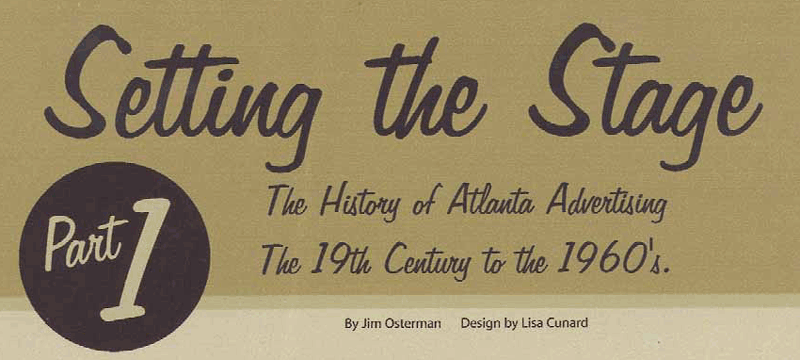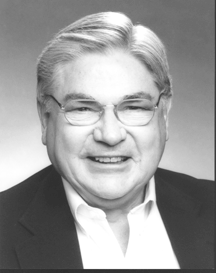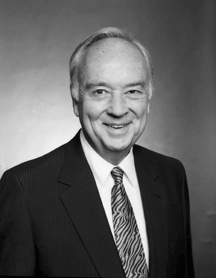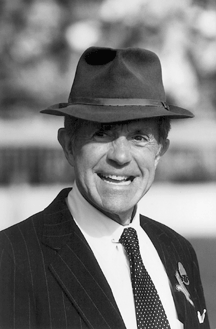
The men, the agencies and their stories: from just this side of being tarred and feathered to the end of post-W.W.II stodginess. Their work and times set the stage for Atlanta's growth into an economic juggernaut, and the growth of Atlanta agencies into national prominence.
In the Beginning?
If you accept the notion that any visual message consitutes some form of an advertising message, then the first ads were the renderings of ancient cavemen. All those crude scrawls of pre-historic cavemen wandering out on the plains hunting for food have commonly been looked upon as historical, recordings of life the way it was way back then. But is it too much of a leap to think they may have been promoting a particular tribe member's prowess as a hunter/gatherer?
If so, one can only imagine the conversation that took place between hunter and historian as the images were being scratched on the cave wall by some dim fire light: "You really need to make the mammoth look a little larger and more menacing," the first client might have "suggested." "And make me a little smaller, so it looks more impressive. Oh, and don't forget to put the clan's symbol down at the bottom and to the right. But it needs to be much bigger, so passing tribes can see it more easily." All of which might have earned a rock to the head of the first "problem" client, a solution many modern day advertising professionals have probably been tempted to employ.
Advertising as a medium has been around in one form or another for centuries, but until recently, it was not thought of as a way someone might be able to earn a living.
Labor Pains and Birth
The historical timeline of the Web site www.admuseum.org tells us that a "for sale" ad for a rich man's palatial estate ran in The Boston News Letter in 1704, possibly one of the first paid, media placed advertisements. It would take close to a century for the medium to gain enough believers that it had any real momentum. Indeed, advertising may have been ove of the original do-it-yourself projects.
In the 1800's flamboyance and outrageous claims were the order of the day, as typified in the posters of P.T. Barnum's circus or the claims of so called patent medicines. There was no Better Business Bureau or local television news consumer advocates back then to keep anyone honest.
According to the Duke University business school archives, the first ad agency in the country opened in 1841. A man named Volney P. Palmer hung out his shingle not in the future ad metropolis of New York, but down south a bit in Philadelphia. New York's rise as the Mecca of advertising would come slowly. For example, in the 1860's it would take the increasing demand and interest in Civil War news to compel The New York Times to start producing a Sunday edition. At that same time there were just 20 ad agencies in New York City.
Down South
Closer to home and not much later, 1893, an Atlanta pharmacist trademarked a sugary concoction he would name Coca-Cola and gave it a distinctive script logo. That logo was used in all manner of advertisements, reinforcing not just the name of the product, but the look of it as well. One could see it at passing glance and get the all-important "brand impression," though no one was using such buzzwords back then.
Though it would hardly fund the cost of stamping bottle caps today, Coke's total advertising budget in 1901 was $100,000, asounding at the time. The soft drink maker hired The D'Arcy Advertising Company, headquartered in St. Louis, as its agency of record in 1907. That agency would subsequently open an office in Atlanta to service the account, which is still technically in business though the D'Arcy name has been gone for more than a decade. Things were off and running in what was becoming the hub of the Southeast business community, ore or less. Quite a bit less, actually. One only has to look at a 1910 edition of The Atlanta Constitution. An announcement appears touting a supper meeting for The Atlanta Ad Men's Club: "one hundred strong" the announcement boasts, reflective of the times when women probably did not even get any consideration for a position handling the clerical responsibilities. The announcement promoted an evening program on the virtues and methods of successful retail advertising. The speakers on the program that night were not, however, leaders in the agency community, but several local retailers. It reflected a time when clients were more likely to handle their advertising chores themselves.
There were not enough ad agencies in Atlanta at the time to truly consider what existed as a true agency community. Theis was not a case of the South being backward and unable to muster the sufficient intellect or ambition. To provide some context, however, it needs to be pointed out that the agencies up north, where the discipline was still in its early stages, were in the process of having to invent the business as they went along, in some cases having to justify their existence to clients.
It was during this era that department store magnate John Wanamaker would express his feelings that half his ad budget was wasted but he didn't know which half. That statement was not so much an indictment of the agency business as it was acknowledgement that client and agency were not exactly sure what was being created, where it was headed or how it could be used most effectively.
There was a growing sense that advertising could be a powerful tool to increase a company's sales, especially when one considers that the country was truly starting to spread out, which was a boon to those who could be in multiple markets. The era of every city having its own set of products that were known only to the town's borders was rapidly disappearing. Though it pales in comparison to today's reach of the internet, the country was starting to "shrink" as methods of transportation and communication improved.
Back down in Atlanta, agencies weren't spending the bulk of their time creating ads so much as they were having to sell clients on the concept of being used at all. The first shops in the city were more media selling and placement services than strategic marketing partners. And that required a pretty savvy sales job just to get one's foot in the door with a major client.
The origins of the Atlanta advertising business, not to mention the ad business as a whole, was not centered on the creative product or account planning but as a service to handle media buying and selling. Up to this point the clients handled the creativity, not to mention the placement. Creativity was seemingly defined as plastering the name of the company in big, bold letters with long body copy and no concern whether the right audience was being reached.
According to Gordon Sawyer, one of the founders of Atlanta's Sawyer Riley Compton and something of a historian of the advertising business, the whole concept of an agency handling the media was looked at with more than a little suspicion. Why hire someone to handle the media, primarily newspapers, when a company could deal with it themselves and not have to pay a commission? Those men involved in the ad agency business in Atlanta were creating a creature they would deride decades in the future: the spendthrift middleman.
Other questions followed. How much was fair compensation ot the agency? What were an agency's credentials that proved they were making the right placements? And, most importantly, could agencies be trusted to pay the placement bills?
The philosophical conundrum of the latter question became a hard reality when credit managers at newspapers became the entry point for any firm wanting to be recognized as an agency. The issue of an advertising firm's financial solvency was its unique selling proposition in the early part of the 20th century.
In order to give some comfort and reassurance to newspapers, the Southern Newspaper Publishers Association (SNPA) was formed in 1903. That group developed an accreditation program for ad agencies. If you could get the SNPA seal of approval, you had at least an entree into the newspapers' advertising managers, but getting the seal meant your balance sheet had no red ink staining its pages and you had no creditors left holding your bad paper. It was potentially good for agencies because it would mean they did not have to do a dog and pony for every newspaper it wanted to place advertising in. The bad news was, for the seal to have any credibility with its audience, it was very tough to get.
As a result, some shops were squeezed: you needed to have clients to stay in business, but to get clients you had to prove you were already a viable concern. And if an agency, any agency anywhere, had the ambition to go national, that meant jumping through a separate set of hoops, this time created and maintained by the American Newspaper Publishers Association. And that group held a stricter set of hoops for agencies to jump through, which meant shops needed pristine reputations. As such, the system favored the established players in the Northeast.
The net result of all these machinations was that the emphasis for an agency was not on having the next hot creative director. A successful advertising agency in those days needed a good chief financial officer. Indeed, even the venerable David Ogilvy, founder of Ogilvy & Mather, was mining for new business when he first opened his doors in New York by offering to do the creative for free if O&M could keep the media commissions.
It was a system that would be in place for a long time. In an interview Sawyer conducted with Bob Lowe, one of the founders of Lowe & Stevens in Atlanta, Lowe pointed out that not having the right credentials could severely hamper an agency. "In the mid 30's media allowed commissions only to 'recognized' agencies," Lowe told Sawyer. "That meant an agency had to have at least two accounts to be recognized by the SNPA or ANPA." Lowe would add that none of the financial institutions or public utilities used an agency at that time. The reason may have been a little bit of suspicion and the fact that they were used to handling their advertising on their own. And some companies never had to put themselves through the pains of making these hard choices, they simply chose not to advertise.
By the 1920's the Atlanta ad community, such as it was, consisted of little more than a dozen shops, but "only one or two were of any size," said Garland Porter, in an interview with Sawyer in the 1980's. And Porter was in a unique position to know.
Upon graduating from college, Porter came to Atlanta in 1923 and worked as a media sales representative, an engraving company executive, penned a column on advertising for various publications and, for close to 30 years, edited advertising and marketing trade publications. He had the ideal vantage point to observe the way the city's agency community would spring up and grow into what it is today.
A turning point for Atlanta's agency community was the end of World War II. When the soldiers came marching home to the South they were determined to make Atlanta the hub of the Southeast business community before towns like Birmingham, Alabama; Raleigh, North Carolina; or New Orleans, Louisiana did. And the ad men were no different. They had made up their minds that the agency business was not just going to exist in Atlanta, but thrive and become the Mecca of the region.
Liller Neal and Battle, which would last into the 80's, would make local history when it became the first Atlanta shop to be accepted into the ranks of the American Association of Advertising Agencies (4A's). Burke Dowling Adams (BDA) came south to Atlanta to service the growing Delta account. That agency, which would become BDA/BBDO and then BBDO South, would keep the air carrier as a client into the 90's.
A small measure of respect came to the city as several national agencies opened branch offices. Indeed, according to Sawyer, of all the agencies, that had attained 4A's status in 1959, only five out of twelve were local. Some local agencies would try and establish themselves in other cities, only to find out that it was difficult to export success from one market to another.
Many of the men who would build and run the agency business in Atlanta into the 1960's found their calling post-war. In that era, women did not hold a place in the senior ranks of ad agencies, even during the war years. Here are some of the stories of the men who set the stage for Atlanta's growth, and Atlanta's agency business.
Stories and Voices

Jack Bolton
While a student at Emory University, Jack Bolton's education was interrupted when he was drafted to serve in the armed forces during World War II. Upon discharge, he went to New York to study at Columbia University, where he would earn his degree. In January of 1953 he went to work for CBS in the television division. His contemporaries would include a wire service reporter turned radio war correspondent Walter Cronkite, 60 Minutes creator Don Hewitt and broadcast news pioneer Frank Stanton. "No one knew what television was going to become," Bolton said.
Bolton moved into the agency business with The Katz Agency, a media firm, a little over four years later, as network television salaries were not as lucrative as they are today. His return to the South came in 1962. "I was married and the little guys were coming and I went with Katz," he remembered. "In 1962 they asked if i'd be interested in going down to Atlanta."
Back in the 60's Atlanta was perceived as a backwater area. Getting clients to sign on frequently required competing media companies to work together. Bolton recalls pitching a client with a colleague from another firm. "We figured we'd sell them on television and sort things out later,"he said. "It worked."
There was also some educating of those up in the home office. "I think New York thought the South was all in one place," he said. "They called once and asked if we could make a run down to Miami and back in a few hours or something."
In 1982, as a cost saving move across the company, the Katz bosses up North let Bolton go. When the word hit the Atlanta community his staunchest business competitors banded together to throw him a party. He started his own firm, and is still active today.
Matt Connor
In 1947 Matt Connor mustered out of the Navy and came to Atlanta with the ambition to work in the agency business. One of the places he interviewed was at Tucker Wayne, where was advised to first get some experience in the ad department of The Atlanta Journal-Constitution. He took the advice to heart and more than paid his dues during his two years at the paper.
"I was an advertising solicitor," he said. "I was the guy who sold advertisers on advertising in the Constitution. Sometimes I even wrote the ad. I had been an officer in the Navy for five years, but I found myself working for young men who were 18. Or younger."
After his time at the paper he made his way into Tucker Wayne, which was becoming one of the leading agencies in the Southeast and starting to look beyong its regional borders. In fact, the agency was so confident in its abilities that it advertised itself as a shop that could take products into national markets, a fairly ballsy claim for the time by an agency in Atlanta. Tucker Wayne began business as James A. Greene & Co. Green, according to Connor, had "taken out a license to write advertising" back in 1921.
"When I came in agencies were still making a 15% commission on the media they placed," he said. "Television came along at a time when Atlanta was really growing as a business center and the business was very good for the city." Connor came into the agency as an account man, but back then there was much more involved. "Any account guy worth a damn could write his own copy," he said. "Then you'd get a layout and take it down to the client yourself. Then, all of a sudden, it got specialized. There was an art department and a copy department. Then they were merged into the creative department and they were telling the account guys to leave them alone and take their finished work to the client."
One of the benefits of being in a growing business in a growing town was that the unwritten rules were established locally by the people running the agencies. As such, it was easier to enforce the gentlemen's agreements. "You didn't solicit for business below the rate card from the media and you never cut your commission under 15% to win an account," Connor said. "Now you have too many agencies and too little business. Then the clients get squeezed so they squeeze the agency, and the agency agrees to take an account on for four percent and it doesn't work and the client has to find a new agency every couple of years."
Tucker Wayne was good to Connor. He rose through the ranks before retiring during the 90's as chairman of the board. But if he could do it over, it might have been different. "I'd been a pre-med student before World War II," he said. "I was really interested in becoming a doctor. After the war I didn't have sense enough to go back."

Don Elliot Heald
As student at the University of Florida, Don Elliot Heald worked at the campus radio station and enjoyed it so much, he decided to change his major to broadcasting and journalism and make it his career. "I thought it was a fun thing to do," he said. "When I got out of school I needed a job. I was an announcer and I knew I wanted to work at a major station in a major Southern city."
It would take Heald three jobs before he made it to Atlanta to go to work for WSB radio. The station, which has always dominated its home market and has a signal that reaches throughout the Southeast, had signed on the air back in 1922. Heald started as an announcer in 1950. Within five years he was promoted to news director, sales manager, and finally general manager. His arrival was just a short two years after the station had added television.
"Back then the agency community was dominated by Liller Neal Battle & Lindsey, Tucker Wayne and, of course, BDA, which had Delta," he said. "The ad community was very social. There was a lot of camaraderie. We didn't raid each other's staff. We went to ad club together and hung out together."
Heald would serve as president of the Atlanta Ad Club and would be recognized for his involvement and contributions to the ad community by being awarded the Ad Club's Silver Medal Award. "It really was the good old days," he said.

Cot Campbell
Like others who came to town to work in the ad business, Campbell did not travel in a straight line. "I had been on some newspapers in Florida and I'd spent some time kicking around the country and misbehaving," he said. "I came to Atlanta and got a job on the assembly line at the Chevrolet plant in 1951."
With a little bit of writing in his background and a lot of brass, Campbell applied for a job with Burke Dowling Adams (BDA). At the time the agency was best known for its long relationship with Delta, which would last into the 90's and C&S Bank, now part of Bank of America. "I wrote copy and TV and radio for a couple of years, then I went to New Orleans," he said. I came back to Atlanta and caught on with a media rep firm, then I was hired by Liller Neal. I stayed there from about 1956 to 1964."
Part of what defined Atlanta during that time, Campbell said, was the energy and ambition. "Back then it was difficult to fail," he said. "It was the ideal community. Atlanta was dying to be thought of as a big town."
It was around this time in the advertising business nationally that creative Bill Bernbach was starting what many call "The Creative Revolution" in New York. His agency, Doyle Dane Bernbach, was creating some of the best advertising. Ever. Luke Sullivan, in his book "Hey, Whipple, Squeeze This" wrote: "From all the advertising, texts, articles, speeches, and awards annuals I've read over my years in advertising, everything that's any good about this business seems to trace its heritage back to this man, William Bernbach - creativity's ground zero."
Campbell and Jack Burton would leave Liller Neal in 1964 to open Burton-Campbell. The pair was heavily under the influence of Bernbach and moved forward on the assumption that there was no agency operating in the market that was even trying to measure up to Bernbach. "We had been with a conservative agency we wanted to be able to do some exciting advertising," Campbell recounted. "We had one account, Sea Pines Plantation on Hilton Head Island."
Burton-Campbell would go on to become one of the most successful and creative agencies in the Southeast and would start to snare some national accounts as well. In the process it would change the agency landscape by dint of its ability to lure major national companies to its client roster and serve as an inspiration to others.
The agency would do work unlike other shops in Atlanta and its roster would include talents like Anne Rivers Siddons, who would become a best selling author, and Hugh Wilson, who created television's WKRP in Cincinatti. "I loved the people in the ad business," Campbell said. "They were zany, creative, sharp people. We had a lot of fun and not a lot of rules."
Campbell would leave in 1973 to open Dogwood Stables, which started in Georgia, but is now located in Aiken, S.C.
However, shortly after he and Burton opened their agency, they found themselves in Birmingham. Looking at the results of the local Addy show, one name kept coming up over and over, Tom Little. "Everything that was any good had his name in it," he said.
Little was lured to Burton-Campbell that spring, to help fulfill that agency's desire to become a creative powerhouse in the city and the region. And though no one would see what was coming, Campbell and Burton's vision and Little's talents set in motion a change in the way the advertising business was done in the city.
**This is the first in a three part series about the history of the advertising agency business in Atlanta. Parts two and three will appear in the September/October and November/December issues of Oz Magazine.**
© 2003 Jim Osterman, All Rights Reserved
|
|



